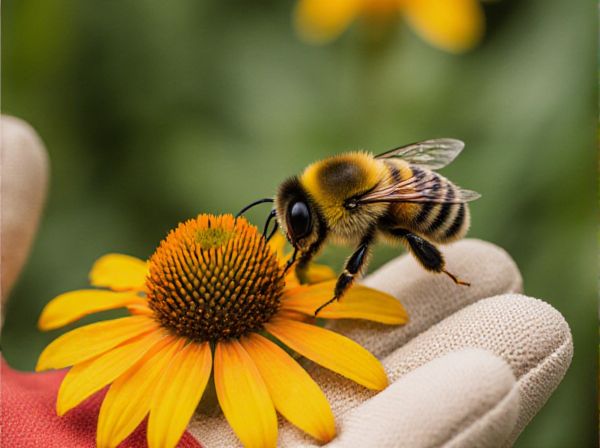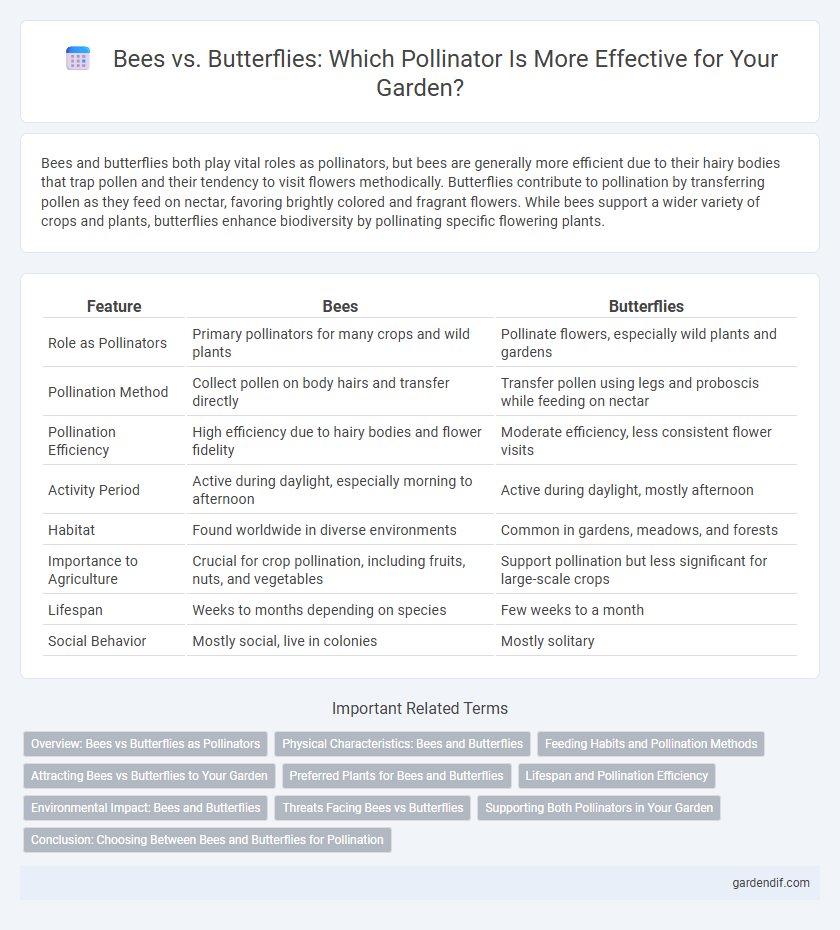
Bees vs Butterflies Illustration
Bees and butterflies both play vital roles as pollinators, but bees are generally more efficient due to their hairy bodies that trap pollen and their tendency to visit flowers methodically. Butterflies contribute to pollination by transferring pollen as they feed on nectar, favoring brightly colored and fragrant flowers. While bees support a wider variety of crops and plants, butterflies enhance biodiversity by pollinating specific flowering plants.
Table of Comparison
| Feature | Bees | Butterflies |
|---|---|---|
| Role as Pollinators | Primary pollinators for many crops and wild plants | Pollinate flowers, especially wild plants and gardens |
| Pollination Method | Collect pollen on body hairs and transfer directly | Transfer pollen using legs and proboscis while feeding on nectar |
| Pollination Efficiency | High efficiency due to hairy bodies and flower fidelity | Moderate efficiency, less consistent flower visits |
| Activity Period | Active during daylight, especially morning to afternoon | Active during daylight, mostly afternoon |
| Habitat | Found worldwide in diverse environments | Common in gardens, meadows, and forests |
| Importance to Agriculture | Crucial for crop pollination, including fruits, nuts, and vegetables | Support pollination but less significant for large-scale crops |
| Lifespan | Weeks to months depending on species | Few weeks to a month |
| Social Behavior | Mostly social, live in colonies | Mostly solitary |
Overview: Bees vs Butterflies as Pollinators
Bees play a crucial role in pollination by efficiently transferring pollen while foraging for nectar, making them primary pollinators for many crops and wild plants. Butterflies contribute to pollination through their long proboscises that access deep flowers, supporting biodiversity in ecosystems with specialized plants. Unlike butterflies, bees have body structures like hairy legs and pollen baskets that enhance pollen collection and distribution.
Physical Characteristics: Bees and Butterflies
Bees exhibit a robust, hairy body designed for pollen collection, with specialized pollen baskets on their hind legs, whereas butterflies possess slender, delicate bodies covered in scales. Bees have two pairs of transparent wings with a more muscular build, facilitating strong, purposeful flying abilities, while butterflies feature larger, often brightly colored wings with distinctive patterns for camouflage and signaling. The antennae of bees are short and elbowed, contrasting with the long, clubbed antennae typical of butterflies, reflecting their differing sensory adaptations.
Feeding Habits and Pollination Methods
Bees primarily feed on nectar and pollen, using specialized body hairs to collect pollen efficiently, which they transfer from flower to flower, making them highly effective pollinators. Butterflies use their proboscis to sip nectar but do not actively gather pollen, resulting in less direct pollen transfer compared to bees. Consequently, bees contribute significantly more to crop pollination and ecosystem health due to their foraging behavior and physical adaptations.
Attracting Bees vs Butterflies to Your Garden
Planting native flowering plants with abundant nectar and pollen effectively attracts bees, as they prefer flowers with simple shapes and bright colors like blue, yellow, and white. Butterflies are drawn to flat, clustered flowers with easy landing platforms and vibrant hues such as red, orange, and pink, which provide accessible nectar sources. Incorporating a diverse mix of both flower types supports a balanced pollinator ecosystem, enhancing garden biodiversity and plant pollination rates.
Preferred Plants for Bees and Butterflies
Bees prefer plants with bright colors such as blue, purple, and yellow, favoring flowers like lavender, sunflowers, and clover that provide abundant nectar and pollen. Butterflies are attracted to vibrant, fragrant flowers including milkweed, coneflowers, and lantana, which offer nectar sources suited to their long proboscises. Selecting a diverse range of native flowering plants optimizes garden support for both bees and butterflies, enhancing pollination and biodiversity.
Lifespan and Pollination Efficiency
Bees exhibit a longer lifespan, typically living several weeks to months, compared to butterflies that often survive only a few weeks; this extended lifespan enables bees to contribute more consistently to pollination throughout the season. In terms of pollination efficiency, bees are significantly more effective due to their hairy bodies that trap pollen, facilitating the transfer between flowers, whereas butterflies rely mainly on their legs and proboscis, which limits pollen adherence. Consequently, bees play a critical role in pollination services essential for agricultural productivity and ecosystem health.
Environmental Impact: Bees and Butterflies
Bees play a crucial role in pollinating over 75% of flowering plants, significantly boosting agricultural productivity and supporting biodiversity. Butterflies contribute to pollination but are less efficient than bees due to their smaller population sizes and more selective flower preferences. The decline of bee populations poses a greater threat to ecosystems and food security compared to butterflies, underscoring the importance of bee conservation for environmental stability.
Threats Facing Bees vs Butterflies
Bees face significant threats from habitat loss, pesticide exposure, and diseases such as Varroa mites, which have contributed to dramatic population declines globally. Butterflies encounter dangers primarily from habitat fragmentation, climate change altering their migratory patterns, and pollution affecting larval host plants essential for their reproduction. Both pollinators are crucial for ecosystem health, yet bees experience more acute risks linked to agricultural practices, while butterflies are highly sensitive to environmental changes impacting their specific ecological niches.
Supporting Both Pollinators in Your Garden
Bees and butterflies both play crucial roles as pollinators, enhancing biodiversity and crop yields. Creating diverse habitats with native flowering plants, providing shelter, and avoiding pesticides supports their populations effectively. Incorporating a variety of nectar-rich flowers that bloom across seasons attracts and sustains both bees and butterflies in your garden ecosystem.
Conclusion: Choosing Between Bees and Butterflies for Pollination
Bees exhibit higher efficiency in pollination due to their hairy bodies and behavior patterns that maximize pollen transfer, making them essential for agricultural productivity. Butterflies, while less effective in pollen distribution, contribute to biodiversity and pollinate specific flowers that attract their feeding habits. Selecting between bees and butterflies depends on the crop type and ecological goals, with bees preferred for intensive pollination needs and butterflies favored in habitat restoration and ornamental gardens.
Bees vs Butterflies Infographic

 gardendif.com
gardendif.com